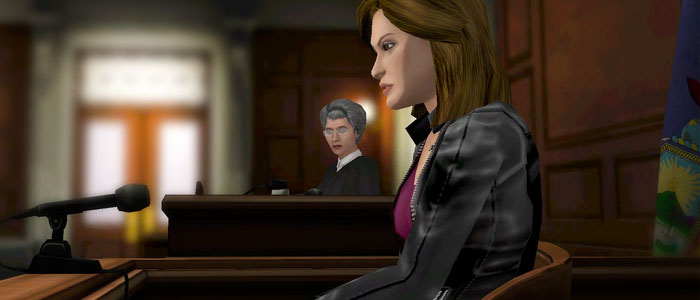[tab:Review]
Before Law & Order became slightly humorous for being on 24 hours a day (thanks to the TNT and USA networks), it broke ground by finding a balance between likeable, realistic characters with their own stories and a format that allows viewers to watch almost any episode in any order. When the original Law & Order was canceled after 20 seasons, it was felt no more deeply than on the streets of New York, where viewing the filming of an episode was a rite of passage. When Telltale announced they were adapting the game for PC, Mac and iOS, I was thrilled, especially when they showed off which characters would be making an appearance.
If you are unfamiliar with the Law & Order format, each episode plays out in the same way. Before the credits, a hapless witness discovers a crime (in this case, each episode is a murder), Detectives investigate the scene and interview witnesses and, after making an arrest, the District Attorney’s office prosecutes the case. The classic Law & Order “clang” sound introducing each scene and the theme song are both present, making this a truly authentic experience.

The first three episodes assemble some of the best characters the series and its spinoffs have to offer. Rey Curtis (originally played by Benjamin Bratt), Mike Logan (originally played by Chris Noth) and Lennie Brisco (played by the late Jerry Orbach) are the highlights for me. The voice actors for those roles are closest to the original actors, with the others faring reasonably well. None of the actors are bad, but there are varying levels of success as they try to imitate the original actors. The actor behind Jack McCoy tried a little to hard to sound like Sam Waterston, for instance, and the actress behind Lt. Van Buren eventually settles in, but starts off pretty rough.
I also greatly appreciated that the episodes wove in the bits of personal story for the characters that helped define them. If you know, for instance, about Rey Curtis’s wife’s MS, the Detective’s exchange with Mike Logan in episode 3 is quite significant. However, just as with the television show, it never gets in the way of enjoyment for those that are just tuning in.
The game plays out in scenes, never mixing gameplay types. You will either be investigating, looking for specific items, interviewing witnesses and suspects or examining witnesses on the stand in the courtroom. The game is handled entirely with the mouse. While investigating, the mouse is used to draw circles around key items or to remove those obscuring important clues. The execution is spotty as you will occasionally have to guess. I was frequently tipped off because an item that didn’t seem to fit in the background. Whether it was shaded differently on purpose to make it stand out, I do not know. What I do know is that with limited guesses to achieve a high score for the scene, guessing felt very counterintuitive.
You will never move your character around. Instead, you can pan the investigation area by moving your mouse to either side of the screen. I’m not sure if this was intended to ease the pacing, which it succeeds in, or if it was in response to the concerns some players had with Back to the Future’s clunky movement system. Either way, it works, but feels a bit limiting. The end result is less LA Noire and more hidden object game.
Things fare better in interview scenes, as you’ll have to challenge witnesses on lies and gently probe for more information. Again, this could have played out very much like LA Noire’s investigation scenes, but without the facial tech to back it up, we’re left with a more simplified system. It works, but the focus seems more on progressing the story than forcing the player to be successful. You can replay scenes and entire episodes for a better score, but I’m not sure why anyone would. You’re never flying blind, as you can access the entire transcript of the episode at any time via the notebook button at the top-left of the screen.

Once you’ve made your arrest, it’s time to enter the courtroom, examine your own witnesses, cross-examine the defense’s and manage your objections when opposing counsel gets out of line. This could have played out like a Phoenix Wright case but, again, Law & Order feels geared to a more casual player. During examination, you’ll have to elicit information and challenge witnesses by citing contradictions.
When opposing counsel is up, you’ll be provided with their personality and the definitions of different improper tactics. Throughout the examination, you’ll be prompted with opportunity to object and, should you choose to, you’ll need to choose your reason from the list. Court cases are won by correctly examining and objecting, filling a meter at the top of the screen. The more the case is going in your favor, the more leverage you have when it comes to accepting plea deals or declining in favor of a jury verdict.
Ultimately, Law & Order is a well-paced and enjoyable experience for fans. The combination of hand-drawn backgrounds and cel-shaded character art is a nice blend, marred only by some odd shadow effects. I didn’t experience any glitches with the game other than the odd audio crackle, even with the in-game audio settings turned down.
After the abysmal Jurassic Park: The Game, fans of Telltale’s work were legitimately concerned for how Law & Order and the upcoming Walking Dead would turn out. Thankfully, the developer seems to have left the mistakes of Jurassic Park on Isla Nublar, bringing a quality experience on the streets of New York to PC, Mac and iOS with their latest outing.
Review copy of the game provided by publisher.
[tab:Screenshots]
[tab:END]
